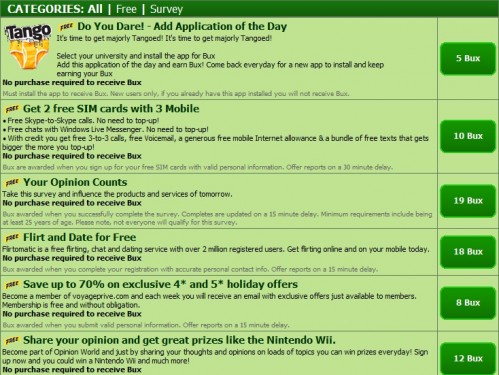I’ve been working on this for a while, but recent developments have somewhat increased the urgency for me to actually get around to finishing this. While I’m sorting out the juicier bits, lets make sure we’re on the same page regarding terms, and what offer walls are.
Offer Walls, or “Advertising Payment Gateways” are most commonly associated with social games on platforms such as Facebook. For the game makers it is a great way to get some cash out of users who recoil from the idea of spending real world money. This is a typical example, from the Facebook game “Island Life”.
Social Games are where this system began, but it has been slowly working its way into other sorts of online games. While I’ve been working on this, DDO has announced, and implemented the very same day, exactly such an offer wall for Dungeons and Dragons Online, cleverly called “The Offer Wall”. In an almost parallel announcement, Nexon, the makers of such games as Maple Story, have also started using the same Offer Wall system, Super Rewards.
There are essentially four parties involved in what happens.
The Offer Brokers
Middlemen standing between the content providers who need to monetise their content, and the folks who want something out of you. They have API which you can easily plug in to your existing website or game with a minimum of fuss. Super Rewards and Offerpal are two of the biggest. It’s a rapidly shifting industry, as the smaller players are being taken over and absorbed by the larger.
The API creates an offer wall, as seen above, on the content providers site. It’s simply a list of offers and associated point reward, clicking on which will send you to a page of the advertiser’s choosing.
The Content Provider
The Content Providers are the folks who make the game or website that needs to be monetised. So far as Offer Wall usage in gaming is concerned, the content provider typically creates (or already has) their own currency, be it godfather dollars, gold coins, or Turbine points. This currency is used for buying items, cosmetic alterations, or advantages within the game. They then set an exchange rate with the offer broker, so the API knows how many points to offer for any given deal.
The Advertiser
Meanwhile, at the other end of the business, you have the advertisers. (That title is overly kind to a lot of them, but we’ll go with “advertisers” for them in general terms.) They create the sites you clickthrough to, set the conditions under which they’ll pay, and decide how much they’re willing to offer when those conditions are met. Typically, they either want the user to give them money, or to give them something they can sell, such as personal data.
The advertiser is not necessarily who you think it is. You may end up at something that looks like it belongs to an energy or car company. They’ll be the ones paying the advertiser for a lead once you fill the form in, but they are not the ones who submitted the offer to the offer broker. In many cases the offer is a package of such sites, with each one popping up after you finish the previous, and all needing completion for the user to qualify for points, resulting in several payments to the advertiser.
The User.
That’s you and me, clicking on neat sounding offers to get points to spend in our games.
So, in theory at least, the offer broker takes all these deals, from myriad sources, and makes them appear on the content providers site for the user to view. The user clicks an offer, and does whatever the offer requires them to do. This triggers a payment to the offer broker from the advertiser, and then passes some of that along to the content provider, who then gives the user the promised amount of game currency.
Where it gets complicated.
That all seems fairly simple, thus far. Where it gets complicated is that the offer brokers are also advertisers. They use eachother’s systems to funnel their own advertiser customers, to increase their reach onto websites that the offer broker does not have a direct link to.
So advertiser A might send their offer to broker B. Broker B puts that offer on the offer walls they directly control, but also creates an encapsulating offer which they place with broker C. Broker C might even do the same, sending it all to Broker D, with it finally ending up on Content Provider E’s website. Of course, Broker B’s offer to Broker C is conditional on Advertiser A’s conditions being met, and so on. Should the User click through and satisfy Advertiser A’s conditions, A pays B the agreed sum. B takes their slice, and passes the rest to C, who does the same. Eventually the Content Provider gets their share.
That’s alright, so far as it goes, but the problem is that it makes it very hard to figure out exactly who is responsible for what. Anyone who has taken the time to look at the offers on different offer brokers walls will have noticed that they’re pretty much identical.
You might ask, “But Ark, couldn’t the content provider make a lot more money if they cut out the middlemen, and worked directly with advertisers?”
Theoretically yes, but the overheads from running it yourself may or may not exceed the expected gains from dealing with advertisers directly. That is the usual reason you will receive, and it is certainly a fair one. After all, they’re gaming companies, not advertising agencies. But there is another reason, which I believe is central to the profitability of the enterprise, and without which the whole thing falls apart.
To be continued in Part 2: Plausible Deniability of Responsibility.
